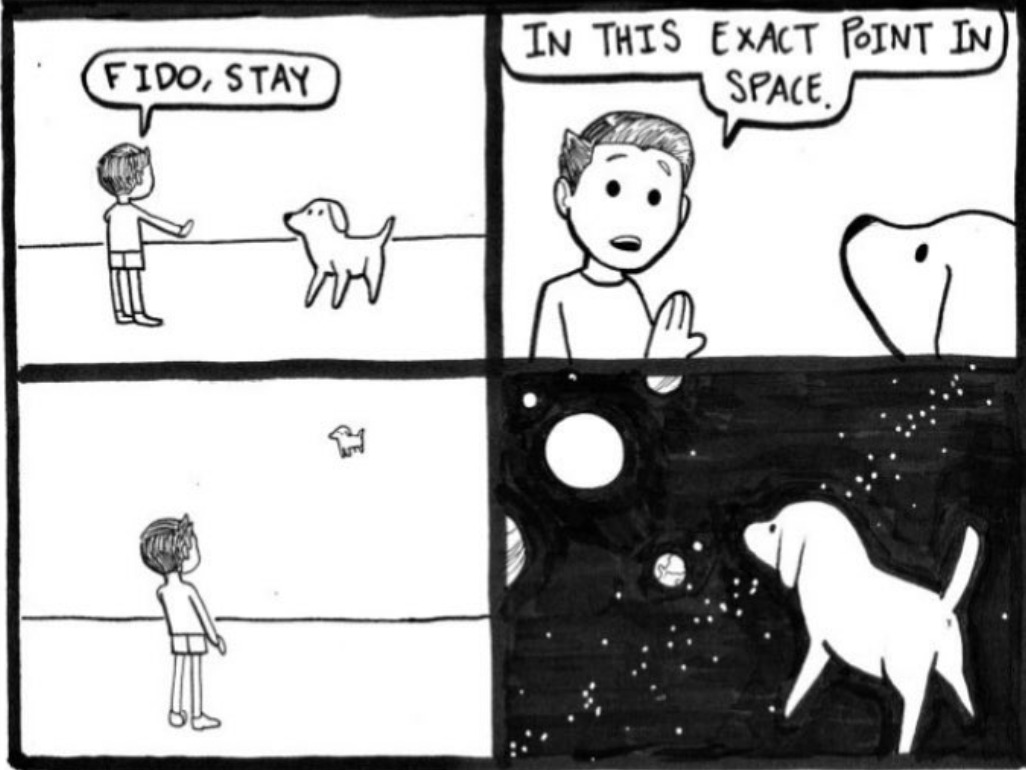So you’re telling me there are space ghosts, from coast to coast? 😮
I’ll be dead long before you were born and I’ll be dead long before you’ll be dead.
We already had a discussion about how that doesn’t make sense with this different comic: https://lemmy.ml/post/14518058

Who’s “we” tho? It’s like a 4 month old post.
Funny tho I wonder if the artist read that thread and got the idea for this comic or if it’s just a case of like minds.
I wonder …

Which is probably what inspired this other comic.
Yeah i has issues with that one this one makes more sense for amount of deaths per day
Right, at the very least it would be a non overlapping spiral, as our sun orbits the galactic center
That explains why there are no ghosts.
No Earth ghosts, only… Space Ghosts…
I have a memory of seeing this exact idea in another comic on here but can’t find it! (Assuming it is a case of multiple discovery and not plagiarism)
Thank you for this daily dose of existential dread 👌
Awesome idea for a Lovecraftian horror story. Maybe the ghosts leave a scent trail that attracts a ghost-eating planet-sized alien
That alien’s name?
Pac-Man.
Reminded me of the movie Final Fantasy: The Spirits Within (2001), except the ghosts are alien ghosts, not human ghosts.
This is incorrect. Ghosts do have mass, they just don’t interact with the EM force and only through the gravity, the strong and the weak interaction (and a fifth interaction that we don’t know about). That’s right, all that dark matter and dark energy is actually ghosts.

This is the best explanation I’ve heard for dark matter that doesn’t involve the assumption that our cosmological models are completely correct.
Can we define ghosts simply as the extinguished consciences of sentient life? So, dark matter and dark energy are the thoughts and memories of our universe.
With no mass they will continue in a straight line at the velocity they were at when they transcended.
Ghosts everywhere!

Now we know what dark matter is
The butthole is what really makes this comic
Einstein would like to have a word with you
several physicists are typing…
Eehh objects in motion stay in motion? Does that apply to ghosts? So would the ghosts fly off in straight lines since no longer subjected to suns gravity ??
Does newton’s laws apply to massless objects?
I don’t see how. The law of motion for massless things seems to be “must stay in motion at c in a vacuum until smashing into something, slowly turning into something weird as it loses energy due to the expansion of the universe.”
Massless objects always move at the speed of light (photos are massless). More important here is, that easy is not on a uniform motion, but rotating around sun, which is rotating around… So even if they remain in their last motion, their path would cover from earth… But motion relative to what? The only special frame of inertia is the cosmic background, and that statement is still under debate
What’s stopping them?
(Pun very much intended)
Morale of the story: Take out as many people as you can when you go so you’re not lonely for eternity.
I think about this way more than I’m happy to admit.
I always thought that this would be a similar issue with time machines. Go back even 1 second and you’re floating in the void.
Depends where you place the coordinate origin, no?
I guess it depends on the sort of time machine. I’m thinking the H.G. Wells variety- a machine you get in or on and it takes you back in time, but to the same location.
That’s also how it works in Back to the Future.
That’s not what the same location means.
Also, now lets talk about relative speed differences!
What does it mean?
Well if you time trivel to “the same location” then that would be in space somewhere because the planet had moved on.
In films you travel to another location, which is where the earth is now/then.
Also, we rocketeer forwards on this spinning globe, so if you time travel 6 months, the planet will be going in the opposite direction (and also be on the other side of the sun ofc.) so iven if you move yourself there, you’d get smashed against the planet at high speed or ejected away from it at high speeds probably be killed by the atmosphere if by nothing else.
Well, but general relativity teaches us that all coordinate systems (also constantly moving, but not accelerating ones) are equally relevant. This means that the one with earth as it’s origin is as correct as one where with the center of the galaxy (or the sun ) as is every other. So the one where earth moves somehow through space is just as random as any other.
That’s actually kinda my head cannon as to why the doctor in doctor who is so hands on when piloting the TARDIS a time machine that only travels through time is useless because you can’t affect history while floating out in space and it’s also dangerous if you happen to pop into existence inside a block of dirt the more I think about it doctor who is a pretty realistic depiction of what time travel will be like even with the TARDIS moving air out the way before landing instead of creating a shockwave from TARDIS molecules materializeing inside of atmosphere molecules
Relative to what? That makes no sense.
Relative to the Cosmic Microwave Background. Seems to be the closest thing to an absolute reference frame.
The cosmic microwave background has no center, any claims that it even has a direction is controversial.
Is it controversial? I thought it was pretty established. In Wikipedia it says:
From the CMB data, it is seen that the Sun appears to be moving at 369.82±0.11 km/s relative to the reference frame of the CMB (also called the CMB rest frame, or the frame of reference in which there is no motion through the CMB). The Local Group — the galaxy group that includes our own Milky Way galaxy — appears to be moving at 620±15 km/s in the direction of galactic longitude ℓ = 271.9°±2°, b = 30°±3°.[88] The dipole is now used to calibrate mapping studies.
Don’t cite Wikipedia. Look at the tiny numbers in blue, click the one next to the statement you want to verify, it will show you the source of the information at the bottom of the page next to the matching number.
Well, following the main reference in the Wikipedia page leads to this:
The implied velocity for the Solar System barycenter is v = 369.82 ± 0.11 km s−1, assuming a value T0 = Tγ , towards (l, b) = (264.021◦ ± 0.011◦, 48.253◦ ± 0.005◦) [13]. Such a Solar System motion implies a velocity for the Galaxy and the Local Group of galaxies relative to the CMB. The derived value is vLG = 620 ± 15 km s−1 towards (l, b) = (271.9◦ ± 2.0◦, 29.6◦ ± 1.4◦) [13], where most of the error comes from uncertainty in the velocity of the Solar System relative to the Local Group. The dipole is a frame-dependent quantity, and one can thus determine the ‘CMB frame’ (in some sense this is a special frame) as that in which the CMB dipole would be zero. Any velocity of the receiver relative to the Earth and the Earth around the Sun is removed for the purposes of CMB anisotropy studies, while our velocity relative to the Local Group of galaxies and the Local Group’s motion relative to the CMB frame are normally removed for cosmological studies. The dipole is now routinely used as a primary calibrator for mapping experiments, either via the time- varying orbital motion of the Earth, or through the cosmological dipole measured by satellite experiments.
Do any references suggest this dipole is under debate?
Ok, I guess the idea that the CMB suggests movement relative to a quasi-absolute reference frame really has become disputed lately… I also found this newer paper by the same authors. It’s a pity, I liked the idea.
But in which frame of reference? Our solar system is also moving, so is our galaxy, our universe is “expanding”, and let’s not even talk about the multiverse, that’s overdone as it is.
That’s the cool part about it! All we have to do is find a way to measure ghosts and we’ll know what the correct universal frame of reference is!
Is the reference frame the CMB? You’d think you could just choose the reference frame at that point and move however you want, but arguing the physics of hypothetical metaphysical beings probably doesn’t make much sense.













